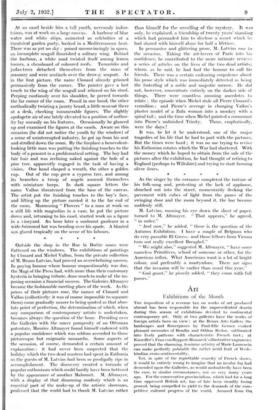Outside the shop in the Rue la Boetie noses were
-flattened on the windows. The exhibitions of paintings by Clonard and Michel Vallon, from the private collection of M. Bruno Latvias, had proved an overwhelming success. In paying honour where honour unquestionably was due, the Magi of the Press had, with more than their customary hysteria in bringing tribute, done much to make of the im- posing occasion a financial success. The Galeries Altmayer became the fashionable meeting place of the week. As the prices of their pictures rose, the names of Clonard and Vallon (collectively: it was of course impossible to separate them) came gradually nearer to being quoted as that abso- lute point of perfection, the determination of which, when any comparison of contemporary artists is undertaken, becomes always the question of the hour. Presiding over the Galleries with the suave pomposity of an Ottoman potentate, Maurice Altmayer found himself endowed with a popular confidence which was seldom accorded to those picturesque but enigmatic monarchs. Some aspects of the occasion, of course, demanded a certain amount of explanation : it had never been suspected that the holiday which the two dead masters had spent in Esthonia as the guests of M. Latvias had been SQ prodigally ripe in accomplishment. The discovery created a tornado of popular enthusiasm which could hardly have been bettered by the appearance of another Mahomet. M. Altmayer, with a display of that disarming modesty which is an essential part of the make-up of the artistic showman, professed that the world had to thank M. Latvias rather than himself for the unveiling of the mystery. It was only, he explained, a friendship of twenty years' standing which had persuaded him to disclose a secret which he had shared with himself alone for half a lifetime.
In persuasive and glittering prose, M. Latvias rose to the occasion. Taking the art-lovers of Paris into his confidence, he contributed to the more intimate reviews a series of articles on the lives of the two dead artists ; whom, as he said, he had had the honour to call his friends. There was a certain endearing corpulence about his prose style which was immediately detected as being the fosterling of a noble and majestic sorrow. Ile did not, however, concentrate entirely on the darker side of things. There were countless amusing anecdotes to relate : the episode when Michel stole all Pierre Clonard's vermilion ; and Pierre's revenge in changing Vallon's plaster model of a Zulu woman into a monkey with a spiral tail ; and the time when Michel painted a cormorant into Pierre's unfinished Trinity. Those, emphatically, were the days !
It was, he let it be understood, one of the major tragedies of his life that he had to part with the pictures. But the times were hard ; it was no use trying to revive his Esthonian estates which the War had shattered. With the money which he hoped to obtain from the sale of the pictures after the exhibition, he had thought of retiring to England (perhaps to Wiltshire) and trying to start farming silver foxes.






































 Previous page
Previous page